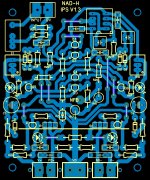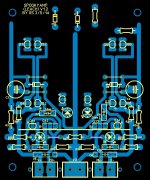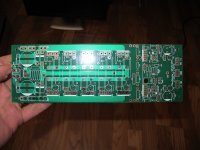The VSSA has a split feedback path but that split occurs on the IPS board and only needs the single NFB connection from the output. I think it will be an easy way to test the OPS and hear a bigger VSSA.
It's time cannibalizing the NAD v.1.2 ?😱
Thimios.
Not at all thimios ....
maybe slight value changes ...

The "biggie" is the servo arrangement.
Here is the difference -
Inverting/ input based servo (V1.2) -
Pro's ....
-Very light load on the op-amp , seems to work very well in practice.
- a real mismatch at the diamond is easily compensated for.
-no apparent increase in THD.
Con's....
A servo failure could be bad , 1V could give 27V at output.
This would also be true with a typical VFA (spooky) as any offset at a high
Z node will lead to gross (dangerous) DC offset.
Non-inverting/current feedback servo (V1.3)-
Pro's ...
... servo failure can be minimized as offset requires more current
to produce ... the servo feedback resistor value self limits the range of
offset in case of total failure.
-slightly better THD and final offset.
Con's... More current required for correction and a more balanced input
diamond pair is preferred.
Then, there is the 3'rd way -
Off-setting the current sources / with a servo ...
This may seem cool 😎 - but it has drawbacks.
When the diamond is running unbalanced , both more THD and higher order
distortion becomes apparent.
Even as the first 2 ways directly inject the correwction into the signal
path , the op-amps PSRR is usually WAY higher than the CFA (110db+).
Using a passive divider would "infect" the signal path far worse than
the op-amps output.
I know I am getting "anal" here. Most likely , a servo failure would trash
the whole input section regardless. Out of 100 OEM amps , 1 servo failure
caused by a aux. supply zener failure .... the output stage actually
survived.
SO ... don't trash the 1.2 , it should also last 20 years. 🙂
PS - servo's are GOOD 😀 ... you could actually remove one device from
the input pair and still have 0 volt offset !!
OS
I am planning my first set being made of e-waste parts, at least mostly anyway. I will attempt to make use of my VSSA boards for a test IPS by only stuffing the input and VAS components. Hopefully I can 'prove' at least one quickly.
Terry, I think there have been more eyes on this one to catch issues and the basic layout has already been built. I doubt these will be duds with any issues.
Everybody here uses ewaste/junkbox parts and gets perfect performance
consistently.
This appears to be a reflection on the "slop" factor I designed these IPS's
with. REAL good parts could lead to perfection.
OS
I have 12 pieces each original Toshiba 2SA1302 / 2SC3281 that I recovered from an old pro amp that will be my first set of outputs. Should make for a pretty respectable junk box build 😀.
I'm waiting to see that the NAD design is completed and that is what I am interested in, at least for now unless someone shows the Spooky is going to be superior in sound and not just in specifications.
After reading all the Accuphase e210a reviews + the detailed schematic
and comparing it to the NADV1.3 ---
Whoa - some will bid/buy/ kill for one of these accuphase's !! 😱
It is so close (nad vs. the accuphase) .. I also want it as MY main
amp !!! This is my selfish reason for refining the NADV1.3. 😀
Even as the 210 is a very well-built setup ... they use a single trafo ,
single pair of main Caps ... no multiplier or current source , I think we
can beat it with the NAD.
OS
Ostripper can you post ltspice file for NAD 1.3?
Attachments
OS,
Very cool! Can't wait to hear this entire circuit with the NAD 1.3 and your scalable output section, who could ask for anything more? Are the component values on the last drawing the best parts from currently available and in production parts? It would be nice to have a design that could stay the same with the same parts for the next five years or so and not need to stock a large quantity of parts to keep production the same over an extended period of time.
PS. What are we going to call this thing, most certainly not a NAD Slewmaster, that could lead to problems I would think. We need a name for this amp so people would know it was your design and identify with it as your design. How about the OS Slewmaster?
Very cool! Can't wait to hear this entire circuit with the NAD 1.3 and your scalable output section, who could ask for anything more? Are the component values on the last drawing the best parts from currently available and in production parts? It would be nice to have a design that could stay the same with the same parts for the next five years or so and not need to stock a large quantity of parts to keep production the same over an extended period of time.
PS. What are we going to call this thing, most certainly not a NAD Slewmaster, that could lead to problems I would think. We need a name for this amp so people would know it was your design and identify with it as your design. How about the OS Slewmaster?
Last edited:
Special parts !!!
NO way ....
NAD input can be ANY 40-60V P/N pair (ksa/c 992/1845 ,1815/1015 ,
even the BCxxx with swapped leads).
The 2nd stage needs to be higher voltage 992/1845 and the
VAS can be ANY combo to-92/to-126.
LED's can be e-waste reds , greens , or the fancy 1$ UV/blue.
With the servo, resistors can be 5% , but 2% are better.
For capacitors .....
Even thimios's ceramics will give decent performance ... but
Antique Radio Schematics and Capacitors for Tube Radios
sells the silver for just .79c !! 😱
OS
NO way ....
NAD input can be ANY 40-60V P/N pair (ksa/c 992/1845 ,1815/1015 ,
even the BCxxx with swapped leads).
The 2nd stage needs to be higher voltage 992/1845 and the
VAS can be ANY combo to-92/to-126.
LED's can be e-waste reds , greens , or the fancy 1$ UV/blue.
With the servo, resistors can be 5% , but 2% are better.
For capacitors .....
Even thimios's ceramics will give decent performance ... but
Antique Radio Schematics and Capacitors for Tube Radios
sells the silver for just .79c !! 😱
OS
How about calling it the Go-NAD?
I actually like that .... 😎😀
Hmmm ... GONADv1.3
The "Rumble" ... between the "Gonad" and the "Spooky" ... 😎
The first amp has some "balls" .... and the second one a "haunting"
sound.
PS - I'm also redoing the spooky with a better layout + CCS trimmers.
(same circuit - thimios's test was very good indeed) !!
Both gonad and spook with be a standard 76 X 90mm layout.
OS
OS Thank for this analytic explain!Not at all thimios ....
maybe slight value changes ...
The "biggie" is the servo arrangement.
Here is the difference -
Inverting/ input based servo (V1.2) -
Pro's ....
-Very light load on the op-amp , seems to work very well in practice.
- a real mismatch at the diamond is easily compensated for.
-no apparent increase in THD.
Con's....
A servo failure could be bad , 1V could give 27V at output.
This would also be true with a typical VFA (spooky) as any offset at a high
Z node will lead to gross (dangerous) DC offset.
Non-inverting/current feedback servo (V1.3)-
Pro's ...
... servo failure can be minimized as offset requires more current
to produce ... the servo feedback resistor value self limits the range of
offset in case of total failure.
-slightly better THD and final offset.
Con's... More current required for correction and a more balanced input
diamond pair is preferred.
Then, there is the 3'rd way -
Off-setting the current sources / with a servo ...
This may seem cool 😎 - but it has drawbacks.
When the diamond is running unbalanced , both more THD and higher order
distortion becomes apparent.
Even as the first 2 ways directly inject the correwction into the signal
path , the op-amps PSRR is usually WAY higher than the CFA (110db+).
Using a passive divider would "infect" the signal path far worse than
the op-amps output.
I know I am getting "anal" here. Most likely , a servo failure would trash
the whole input section regardless. Out of 100 OEM amps , 1 servo failure
caused by a aux. supply zener failure .... the output stage actually
survived.
SO ... don't trash the 1.2 , it should also last 20 years. 🙂
PS - servo's are GOOD 😀 ... you could actually remove one device from
the input pair and still have 0 volt offset !!
OS
Waiting for the young NAD V1.3

Best regards.
Thimios.
OS you have post a link for cheap capacitors.....
Did you see this.
"Minimum order is $25.00 (before shipping).
The fixed shipping charge for USA and Canada is $7.90 U.S. All USA order are mailed via Small Packet Airmail. Within Canada small orders are mailed "Other Lettermail" in padded mailers, while larger orders are mailed "Expedited Parcel". The shipping charge is fixed at $7.90 for both USA and Canada. You save money...it does not matter how large your order is, the $7.90 fixed charge will be honored.
We are glad to ship world-wide. For countries other than USA and Canada, please ask us for actual postage cost.
For Canadian customers, the appropriate HST/GST will automatically be added by paypal at check-out.
Free air mail for Capacitor and Resistor Kits for USA and Canada. Overseas customers add $9.90 per kit for airmail."
Note: uF = mF = mfd and pF = mmF = mmfd
Prices, Terms and Product Availability are subject to change. The above capacitor prices and terms of sale are effective March, 2014.
25+7.9+9.9=42,8+taxes sharge...
Not so cheap,especially for us in Europe🙁
Did you see this.
"Minimum order is $25.00 (before shipping).
The fixed shipping charge for USA and Canada is $7.90 U.S. All USA order are mailed via Small Packet Airmail. Within Canada small orders are mailed "Other Lettermail" in padded mailers, while larger orders are mailed "Expedited Parcel". The shipping charge is fixed at $7.90 for both USA and Canada. You save money...it does not matter how large your order is, the $7.90 fixed charge will be honored.
We are glad to ship world-wide. For countries other than USA and Canada, please ask us for actual postage cost.
For Canadian customers, the appropriate HST/GST will automatically be added by paypal at check-out.
Free air mail for Capacitor and Resistor Kits for USA and Canada. Overseas customers add $9.90 per kit for airmail."
Note: uF = mF = mfd and pF = mmF = mmfd
Prices, Terms and Product Availability are subject to change. The above capacitor prices and terms of sale are effective March, 2014.
25+7.9+9.9=42,8+taxes sharge...
Not so cheap,especially for us in Europe🙁
Last edited:
thimios,
This is where a group buy on the components would come in handy for you and the rest of us. A larger purchase from Digi-key or someone else in large quantities can lower the individual piece parts cost significantly and then someone can just drop the set of parts in the mail to you. The only unknown is the customs charges when you do that unless someone can just call the package a gift and not have anything but the mailing charges. The only problem becomes all the different input sections that OS has created but if we can limit that to either the Spooky or the Go-Nad then that could help. Perhaps even make a set of boards and parts to allow for a dual build of both input sections so we can all make a comparison of which topology is the best liked in listening tests.
This is where a group buy on the components would come in handy for you and the rest of us. A larger purchase from Digi-key or someone else in large quantities can lower the individual piece parts cost significantly and then someone can just drop the set of parts in the mail to you. The only unknown is the customs charges when you do that unless someone can just call the package a gift and not have anything but the mailing charges. The only problem becomes all the different input sections that OS has created but if we can limit that to either the Spooky or the Go-Nad then that could help. Perhaps even make a set of boards and parts to allow for a dual build of both input sections so we can all make a comparison of which topology is the best liked in listening tests.
The difference in cost between the sizes isn't that great.The merging the two boards eliminates one extra tooling cost
25+7.9+9.9=42,8+taxes sharge...
Not so cheap,especially for us in Europe🙁
= 32-33 silver mica caps for even 50$ is still WAY cheaper than the 2-3$ (each)
mouser/digikey charges.
A group buy of 100's could get down to 80c each.
In Europe , do they tax your food/water ? Here , you just rent
your house off the govt. , 7000$/yr just to own (a big lie 🙁) one!!
OS
Last edited:
(below) are the 2 "anal versions" of the tested spooky/Gonad.
Both will have the CCS adj.
Spook will be more compact , with LTP/cascode's closer.
Both will exact 76.2 X 91mm with the servo at the top.
Traces will be 2/1.5mm.
I expect to fill just about every square CM with traces !!
OS
Both will have the CCS adj.
Spook will be more compact , with LTP/cascode's closer.
Both will exact 76.2 X 91mm with the servo at the top.
Traces will be 2/1.5mm.
I expect to fill just about every square CM with traces !!
OS
Attachments
I buy 22pF silver mica on local market, the price is IDR 10.000 or less than $1.
For experiment or first build I will use ceramic.
For experiment or first build I will use ceramic.
Jason,
This version is before you added the multi-pattern holes for the various capacitors and the move of the mounting holes for the heat sink plate? Are there really any major differences between this board and the final version beside the tiny improvements that OS suggested?
This version is before you added the multi-pattern holes for the various capacitors and the move of the mounting holes for the heat sink plate? Are there really any major differences between this board and the final version beside the tiny improvements that OS suggested?
- Home
- Amplifiers
- Solid State
- Slewmaster - CFA vs. VFA "Rumble"


